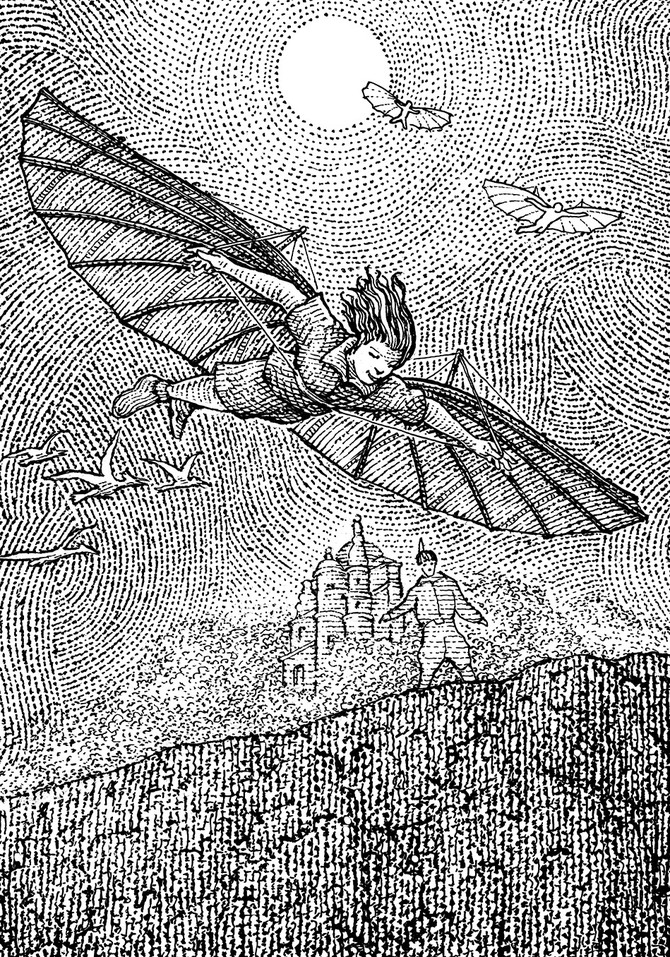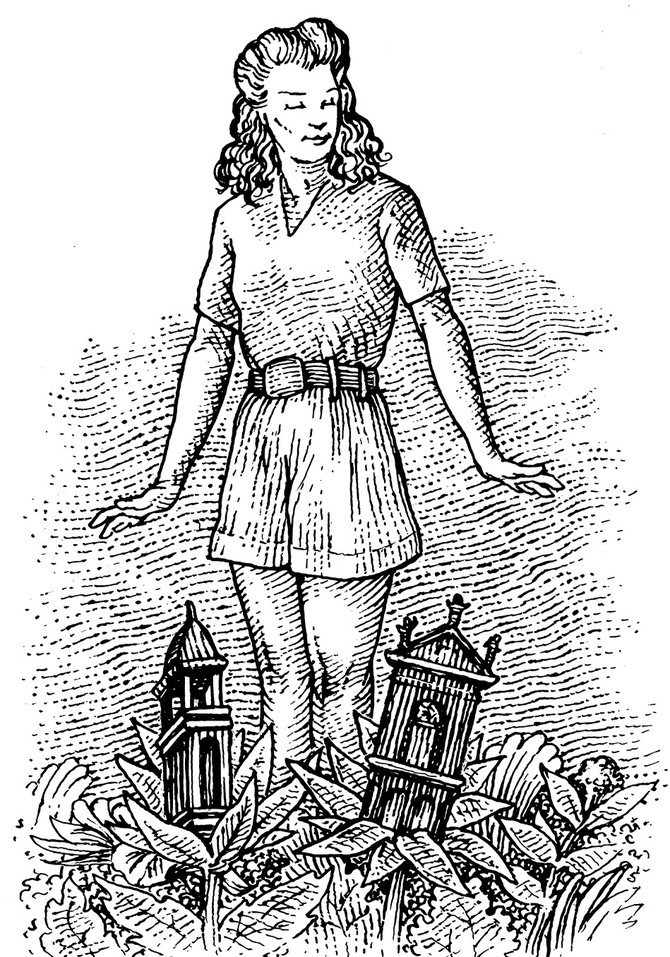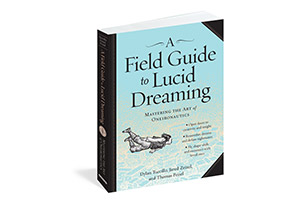How to Control Your Dreams (While You're Sleeping)
The authors of A Field Guide to Lucid Dreaming explain how we may be able to change and guide our dreams while we sleep, making us happier—and able to fly.

Illustration: Mahendra Singh/A Field Guide to Dreaming
Lucid dreaming is the ability to know you're dreaming while you're dreaming. A lucid dreamer is able to go to sleep at night, and wake up within his or her dream. Once lucid, you can explore and even change elements of the dream. You may notice that you're in a location that would normally be impossible (Wait, how did I get to Hawaii?) or perhaps you stumble upon something absolutely absurd (Is that an ostrich driving a car?). Maybe your trigger has more to do with your past (Wait a second, I'm not in college anymore! This has to be a dream!). Typically, lucid dreams are triggered by some sort of inconsistency, something that suddenly causes the dreamer to stop and question his or her reality.
Imagine being free of your physical body, leaving behind silly things like gravity. Picture yourself flying, and doing so in the literal sense, feeling the air rushing across your face, the weightlessness of your body, breaking every Newtonian law out there. Imagine seeing and conversing with the natives of the dream, who provide valuable insights and knowledge about your life. Hidden in this place you can find wisdom and guidance that could change your life.
Imagine being free of your physical body, leaving behind silly things like gravity. Picture yourself flying, and doing so in the literal sense, feeling the air rushing across your face, the weightlessness of your body, breaking every Newtonian law out there. Imagine seeing and conversing with the natives of the dream, who provide valuable insights and knowledge about your life. Hidden in this place you can find wisdom and guidance that could change your life.

Illustration: Mahendra Singh/A Field Guide to Dreaming
The Secrets to Starting
Keep a dream journal... As you jot down more of your nighttime adventures, you'll notice that you often dream about very similar things. For example, you might have a frequent dream about your sister, your pet, the ocean, school, snakes—anything. These recurring dream elements are called dream signs, and they're a powerful stepping stone to lucid dreams. Even now, without knowing it, your dreams contain certain people, events, locations and situations that pop up again and again, dream after dream. Once you identify those personal dream signs, they will essentially act as landmarks in the dream world, a great way to achieve lucidity.
Keep a journal for a few weeks, and you'll begin to see patterns. A dream sign is personal to you. You might have a recurring dream sign that's been with you your whole life, such as a fear of snakes. Dream signs might change frequently as you yourself change, such as suddenly including your new boss. Find a highlighter, read through your dream journal and start underlining the objects, places, people and themes that pop up more than once: a large mansion, owls, your brother Joe, the park, embarrassment. Keep a list of all these dream signs.
Locating and identifying dream signs will train your subconscious to spot them the next time they appear. If you recognize that you often dream about your old girlfriend, for example, you can use this as a trigger for becoming aware that you're dreaming. Tell yourself before bed, "The next time I see my ex-girlfriend I will realize that I am dreaming." Knowing that your dreams speak a familiar language with recurring places, people or themes will be one of the easiest ways to recognize that you're dreaming.
By asking yourself the question, "Am I dreaming?" throughout your day, you will begin to ask the same question while in a dream. Your suspicion of reality will echo into your sleep, bouncing around your mind until—voilà!—you find yourself within the mecca of your own psyche. Reality checks are another cornerstone of lucid dreaming.
If you stop and think about it, you can usually tell if you're dreaming or not: The trick is stopping and thinking about it. It may sound crazy to ask this question when you know for sure that you're awake, but your feelings of lunacy will be justified when you have your first lucid dream. Soon enough, you'll perform a reality check in a dream and realize: "Wait a second, it worked! I am dreaming!"
Keep a journal for a few weeks, and you'll begin to see patterns. A dream sign is personal to you. You might have a recurring dream sign that's been with you your whole life, such as a fear of snakes. Dream signs might change frequently as you yourself change, such as suddenly including your new boss. Find a highlighter, read through your dream journal and start underlining the objects, places, people and themes that pop up more than once: a large mansion, owls, your brother Joe, the park, embarrassment. Keep a list of all these dream signs.
Locating and identifying dream signs will train your subconscious to spot them the next time they appear. If you recognize that you often dream about your old girlfriend, for example, you can use this as a trigger for becoming aware that you're dreaming. Tell yourself before bed, "The next time I see my ex-girlfriend I will realize that I am dreaming." Knowing that your dreams speak a familiar language with recurring places, people or themes will be one of the easiest ways to recognize that you're dreaming.
By asking yourself the question, "Am I dreaming?" throughout your day, you will begin to ask the same question while in a dream. Your suspicion of reality will echo into your sleep, bouncing around your mind until—voilà!—you find yourself within the mecca of your own psyche. Reality checks are another cornerstone of lucid dreaming.
If you stop and think about it, you can usually tell if you're dreaming or not: The trick is stopping and thinking about it. It may sound crazy to ask this question when you know for sure that you're awake, but your feelings of lunacy will be justified when you have your first lucid dream. Soon enough, you'll perform a reality check in a dream and realize: "Wait a second, it worked! I am dreaming!"

Illustration: Mahendra Singh/A Field Guide to Dreaming
The Best Activities to Try
It isn't a surprise that flying is the primary form of travel among dreamers. Most people report that this is their favorite thing to do when they find themselves self-aware in their dreams. The feeling of the wind rushing across your face, the freedom and exhilaration of moving in any direction, free of all limitations, is quite an intoxicating experience.
When it comes to lucid dreaming, one of the simplest but most interesting experiences is walking through solid objects. In the dream world, obstacles only appear to be in your way. A window, a brick wall, a rock face—these things are only illusions, projections from your mind. They are not physical. Objects may feel solid when you touch them, but they feel solid only because you expect them to feel that way. Think of the object as air, and you will pass through it effortlessly.
In a lucid dream, you can create anything. Nothing is off-limits—no object, creature or contraption is out of reach. Your creation can be as large as a mountain or as complicated as a living organism. If you could create the impossible, what would you make?
When it comes to lucid dreaming, one of the simplest but most interesting experiences is walking through solid objects. In the dream world, obstacles only appear to be in your way. A window, a brick wall, a rock face—these things are only illusions, projections from your mind. They are not physical. Objects may feel solid when you touch them, but they feel solid only because you expect them to feel that way. Think of the object as air, and you will pass through it effortlessly.
In a lucid dream, you can create anything. Nothing is off-limits—no object, creature or contraption is out of reach. Your creation can be as large as a mountain or as complicated as a living organism. If you could create the impossible, what would you make?

Illustration: Mahendra Singh/A Field Guide to Dreaming
The Unexpected Benefits
After a few lucid dreams, many people experience a drastic alteration of their perspectives—they realize that there is much more to reality than they currently understand. Dreams often alert us to our problems, and guide us toward a resolution. Read over your dream-journal entries and ask yourself, "Do any of these dreams contain advice on how I can be happier and more whole?" We can record and interpret our normal dreams in order to decode the messages from our subconscious. Sometimes, however, interpreting our dream journals can be tough. It's not always possible to know exactly what your subconscious is communicating. This is where lucid dreaming comes in. You can find lost parts of yourself while actively exploring your inner world.

This slideshow is an adapted excerpt from A Field Guide to Lucid Dreaming: Mastering the Art of Oneironautics by Dylan Tuccillo, Jared Zeizel, and Thomas Peisel.

This slideshow is an adapted excerpt from A Field Guide to Lucid Dreaming: Mastering the Art of Oneironautics by Dylan Tuccillo, Jared Zeizel, and Thomas Peisel.
Published 12/04/2014

